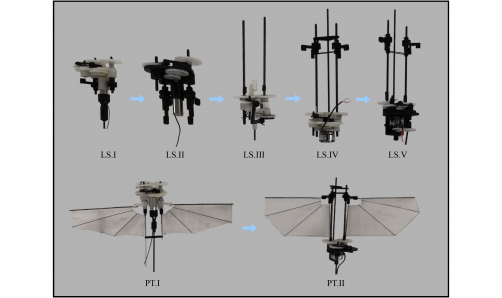Top Stories
Researchers Unveil Breakthrough in Flapping Wing Drone Lift System

URGENT UPDATE: A groundbreaking study has just been published revealing a revolutionary lift system for flapping wing micro air vehicles (FWMAVs) that could transform drone technology. Researchers from Beihang University and Tsinghua University announced their findings in a paper entitled “Lift System Optimization for Hover-Capable Flapping Wing Micro Air Vehicle,” showcasing a significant leap in aerodynamic performance.
The innovative approach integrates elastic energy storage elements at the wing root, mimicking the mechanics of hummingbirds, enabling more efficient and controllable flight. This study addresses long-standing challenges in FWMAV technology, where existing models have struggled with power consumption and maneuverability. The new lift system not only enhances lift generation but also reduces energy use, making these vehicles more viable for practical applications.
In experimental testing, this system achieved a remarkable lift of 31.98 g with a drone weighing only 10.5 g. The prototype, featuring a wingspan of 175 mm, can hover continuously for approximately 1 minute at 50% throttle, demonstrating exceptional flight reliability and efficiency. This development is poised to significantly impact various fields, including surveillance, environmental monitoring, and delivery services.
The researchers, led by Shengjie Xiao, Yongqi Shi, and Zemin Wang, conducted extensive tests on wing parameters such as material, wingspan, and chord length, ultimately developing an optimized wing configuration dubbed 80-455. Through the use of advanced materials like Icarex PC31, they achieved a weight reduction of 30.4% for the fuselage, enhancing its structural strength while minimizing resonance.
The implications of these findings are enormous, as they pave the way for future advancements in drone capabilities, particularly in improving flight dynamics and reducing operational costs. The lift system leverages a crank-rocker mechanism and gear system to optimize the flapping angle, achieving 154° for superior performance.
As the demand for more efficient and agile drones continues to grow, this research could catalyze a new era in aerial technology. Flight tests confirmed the prototype’s ability for rapid ascent and dynamic maneuvers, indicating its potential for both commercial and recreational applications.
For those interested in the full study, it is available for review at https://doi.org/10.1007/s11465-024-0790-6. Stay tuned for further updates as this technology evolves and its applications become increasingly relevant in our daily lives.
-

 Health4 days ago
Health4 days agoRare Brain Condition Discovered More Common in New Mexico
-

 Politics5 days ago
Politics5 days agoPrince Andrew Steps Back from Royal Duties Following Epstein Memoir
-

 Health5 days ago
Health5 days agoRemembering Mary Ingleby: A Life of Love, Teaching, and Music
-

 Sports5 days ago
Sports5 days agoMLS Decision Day 2025: Playoff Spots on the Line as Teams Clash
-

 Science5 days ago
Science5 days agoIdaho State University Launches Haunted Science Laboratory on Oct. 25
-

 World5 days ago
World5 days agoYoung Driver Dies in Collision with Box Truck in El Cajon
-

 Lifestyle5 days ago
Lifestyle5 days agoKent Hamilton Named Southeastern Farmer of the Year at Expo
-

 Business5 days ago
Business5 days agoFirst National Bank of Groton’s Quiet Period Ends October 21
-

 Entertainment5 days ago
Entertainment5 days agoTrump Commutes George Santos’ Sentence, Sparks Controversy
-

 Politics5 days ago
Politics5 days agoNavy Veteran Max Quattromani Launches Campaign for Assessor Seat
-

 Sports5 days ago
Sports5 days agoSaquon Barkley Reacts to James Franklin’s Dismissal from Penn State
-

 Health3 days ago
Health3 days agoScientists Warn: Human Brain Struggles to Function After Midnight









